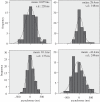Automatic imitation in a strategic context: players of rock-paper-scissors imitate opponents' gestures
- PMID: 21775334
- PMCID: PMC3248720
- DOI: 10.1098/rspb.2011.1024
Automatic imitation in a strategic context: players of rock-paper-scissors imitate opponents' gestures
Abstract
A compelling body of evidence indicates that observing a task-irrelevant action makes the execution of that action more likely. However, it remains unclear whether this 'automatic imitation' effect is indeed automatic or whether the imitative action is voluntary. The present study tested the automaticity of automatic imitation by asking whether it occurs in a strategic context where it reduces payoffs. Participants were required to play rock-paper-scissors, with the aim of achieving as many wins as possible, while either one or both players were blindfolded. While the frequency of draws in the blind-blind condition was precisely that expected at chance, the frequency of draws in the blind-sighted condition was significantly elevated. Specifically, the execution of either a rock or scissors gesture by the blind player was predictive of an imitative response by the sighted player. That automatic imitation emerges in a context where imitation reduces payoffs accords with its 'automatic' description, and implies that these effects are more akin to involuntary than to voluntary actions. These data represent the first evidence of automatic imitation in a strategic context, and challenge the abstraction from physical aspects of social interaction typical in economic and game theory.
Figures


References
-
- Heyes C. 2011. Automatic imitation. Psychol. Bull. 137, 463–48310.1037/a0022288 (doi:10.1037/a0022288) - DOI - DOI - PubMed
-
- di Pellegrino G., Fadiga L., Fogassi L., Gallese V., Rizzolatti G. 1992. Understanding motor events: a neurophysiological study. Exp. Brain Res. 91, 176–180 - PubMed
-
- Gallese V., Fadiga L., Fogassi L., Rizzolatti G. 1996. Action recognition in the premotor cortex. Brain 119, 593–60910.1093/brain/119.2.593 (doi:10.1093/brain/119.2.593) - DOI - DOI - PubMed
-
- Rizzolatti G., Fadiga L., Gallese V., Fogassi L. 1996. Premotor cortex and the recognition of motor actions. Cogn. Brain Res. 3, 131–14110.1016/0926-6410(95)00038-0 (doi:10.1016/0926-6410(95)00038-0) - DOI - DOI - PubMed
-
- Gazzola V., Rizzolatti G., Wicker B., Keysers C. 2007. The anthropomorphic brain: the mirror neuron system responds to human and robotic actions. Neuroimage 35, 1674–168410.1016/j.neuroimage.2007.02.003 (doi:10.1016/j.neuroimage.2007.02.003) - DOI - DOI - PubMed
Publication types
MeSH terms
LinkOut - more resources
Full Text Sources

